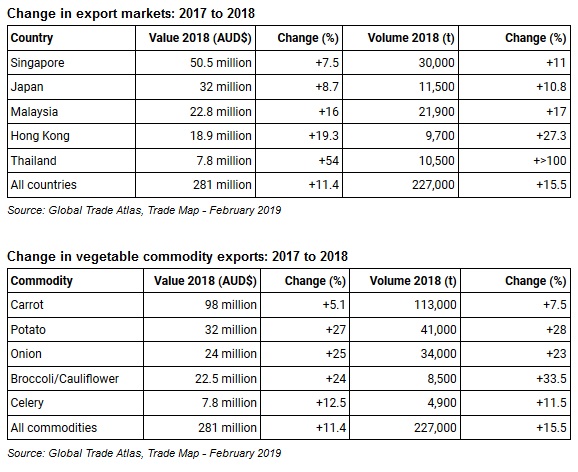Australian veggie exports jump in 2018

Australian fresh vegetable exports rose by 11.4% last year with Singapore retaining its spot as the leading market, while high growth rates were seen for potatoes, onions, broccoli and cauliflower.
The results were released by industry body Ausveg, whose national manager for export development Michael Coote said progress was testament to the hard work of growers who have persevered with the export process.
"The Australian vegetable industry is continuing to experience solid growth in its exports, particularly on the back of strong performing products such as carrots, potatoes and broccoli/cauliflower to different high-value Asian markets," Coote said.
With the AUD281 million (US$199.5 million) result, the industry only needs another 12% push over two years to hit its 2020 target of AUD315 million (US$223.7 million).
The growth in volume was faster at 15.5% to reach 227,000 metric tons (MT), of which carrots accounted for almost half.
Singapore was the leading market with Australian fresh vegetable imports worth AUD50 million (US$35.5 million), followed by Japan, Malaysia, Hong Kong and Thailand; the latter notably provided a 54% uptick to AUD7.8 million (US$5.5 million).
The broccoli/cauliflower category was the biggest riser with growth of 24% in value to AUD22.5 million (US$16 million) and volume growth of 33.5% to 8,500MT.
Coote added the positive outcome was also the result of Ausveg and the wider industry providing opportunities for growers to increase their capability and opportunities to enter export markets.
"The Vegetable Industry Export Program, which is delivered by AUSVEG in partnership with Hort Innovation, continues to support the solid growth in fresh vegetable exports," Coote said.
"In 2018, the program facilitated the development of export capabilities for the industry by bringing 40 buyers into Australia to see local production, taking over 40 growers on outbound trade missions, and up-skilling another 40 growers through export readiness training.
"The continued rise in the value of vegetable exports is particularly impressive when you consider that Australian vegetables are typically lower-priced products that are being grown in a high-cost environment, due to the rising costs of labour, electricity and water."
Coote noted growers were also subject to the effects of fluctuating exchange rates, but nonetheless exports have continued to build.
"The industry is well on its way to reach the ambitious target of AUD$315 million in fresh vegetable exports by 2020 as outlined by the industry’s export strategy," he said.
"We are working with growers to ensure they have the skills and knowhow to improve their ability to export their produce and capitalise on increasing demand for fresh, Australian-grown vegetable produce."









































